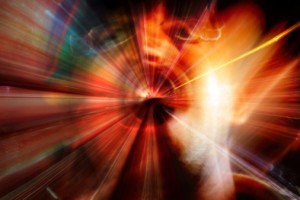Ken Wilber: Theories of Consciousness (Part Two)
By Asher Crispe: April 15, 2011: Category Inspirations, Thought Figures
 In today’s day and age, more and more of us need help with organization. Its not just that our personal living spaces are prone to clutter, but that our inner psychic life is so scattered and over-stuffed with information that its hard to recognize exactly what’s packed into our cranium. Somehow the directory either got lost or was never created in the first place.
In today’s day and age, more and more of us need help with organization. Its not just that our personal living spaces are prone to clutter, but that our inner psychic life is so scattered and over-stuffed with information that its hard to recognize exactly what’s packed into our cranium. Somehow the directory either got lost or was never created in the first place.
Occasionally, when we have one of those rare moments of quiet reflection, we may close up shop and take inventory of our mental files. The trouble is how do we organize what we know? Wouldn’t it be nice to have a fairly reliable system for labeling the items in our personal warehouse of ideas? How about RFID tagging all of our conceptual tools? That would certainly come in handy the next time I want to hammer home my point in an argument.
The integral vision for psychology and philosophy outlined by Ken Wilber, focuses on systematic thinking. There are times when we are running programs across platforms—something akin to computing with a Mac and a PC—and we need a common basis for allowing these different systems of thought to coincide. Wilber’s project is to develop a system of systems, some framework for incorporating all types of knowledge, a multitude of manners of thinking and as much truth as possible.
Wilber attempts to accomplish this with his famous model of ‘four quadrants’ which organize what he calls the ‘four faces of truth.’ One gets the sense that by a ‘face of truth’ Wilber means an aspect. Depending on how you choose to approach reality, by virtue of having selected some interpretive lens, the picture that you see will change. Each has its own ‘validity claim’ according to Wilber, but you need a minimum of four approaches to get the whole picture. Remove any of the four and the resulting system of thinking will be fundamentally incomplete.
What immediately stands out about this schema are the parallels with Jewish thought and particularly Kabbalah. In traditional Kabbalistic discourse, ultimate reality is denoted by the essential name for Divinity, the Tetragrammaton. Although it is not read as it is written, the written characters are taken to signify the whole of Being. Moreover, this name is often referred to by the kabbalists as the “shem ben dalet,” the “name of four letters.” More literally, this Hebrew expression means a name/identity that is the child or branch of four. What are the four? They are the letters yud (י), hei (ה), vav (ו) and hei (ה). For the Jewish mystics, these letters would be understood as four modes of Being or four dimensions of Reality.
These are the minimal number of letters/modes/faces/aspects required to spell out a complete expression of Divine Reality. Sometimes, the kabbalists employ the expression ‘the seal of the King is truth’ as if to say that the King is the be all and end all arbiter and manager of reality who makes an impression or leaves a signature that validates existence itself. This seal of truth is the letters of four lettered name. Thus, truth has a fourfold nature or four aspects to it.
The fourfold model can really be seen in terms of two sets of twofold distinctions (you can think of two squared).
The first of these for Wilber relates to seeing reality divided into interior and exterior dimensions. Interiority marks the personal subjective realm of conscious. Experience is located within me. We are dealing with subjective truth, seeing reality the way I see it. However, inner subjective truths do not provide exhaustive descriptions of reality. There is also exterior objective truth. This is bound up with empirical knowledge about the material world. For Wilber, this is formulated not as a question of how ‘I see it’ but as how ‘it is.’
In the Kabbalah of the Arizal (Rabbi Yitzchak Luria 1534-1572), we find it axiomatically stated that everything in reality processes the aspects of penimiut and chitzoniut—interiority and exteriority. Moreover, the inner and outer, subjective and objective, are like a masculine and feminine pair that is always married. We need to think of them in constant relationship with one another.
The divorcing of the subject and object, inner and outer aspects of reality makes reproduction impossible. So, just as male and female are required in order to produce offspring, the subjective and objective interpenetration catalyzes all of our intellectual creativity. The Genesis narrative perfective captures this relationship with the expression “Adam knew his wife Eve”. This euphemism for marital relations underscores the sexualization of knowledge at the core of the subject-object structure of thought.
For Wilber, the second division casts reality in terms of individual and collective experiences. From a kabbalistic perspective this would hold as well. The notion of klal and prat highlights the distinction between collective and individual experiences. Klal can also mean a generalization while prat expresses a sense of particularity.
Inter-layering these as sub-categories with the first two (inner and outer) produces the four quadrant model that appears over and over throughout Wilber’s vast work. In Wilber’s descriptions, the horizontal axis refers to the inner and outer distinction while the vertical axis captures the categories of the individual and collective.
The next level of analysis that Wilber puts forth is to break down the four quadrants in terms of the intertwined relationships of inner individual, inner collective, outer singular and outer plural consciousness.
Without getting into all of the nuances of each quadrant, let us merely provide a minimal description of each. For a good introduction provided by Wilber himself, see the opening chapter of his work The Eye of Spirit.
Top-Left: Here the inner individual resides. We speak of subjective truthfulness or the world as seen through the “I” or self.
Top-Right: The self is made into an object of investigation. We speak of representational truth that exists in and of itself, that is not in relation to anything else. This refers to an impersonal object as a singular “it”
Bottom-Left: Intersubjective truth is mediated socially or culturally conditioned. “We” produce a mutual understanding through our collective interaction of our aggregate subjectivity.
Bottom-Right: Another manifestation of the “it” or objective consciousness. The key difference here is that objects are not singled out and interpreted discreetly but read as part of a larger web or network of interwoven objects. Thus, the interobjective relates to systems theory, to sets or collections of objects whose meaning emerges from the mesh of relationships.
While Wilber has devoted entire books to unpacking the secrets of the four quadrant model, we will only comment on some simple comparisons with kabbalistic thinking. Notwithstanding the lack of a single way of building the comparison with the four letter name for the Divine in terms of matching the letters with the quadrants, there are remarkable insights to be gleaned from juxtaposing the models.
For starters, each model starts with three terms that expand to four due to the repetition of one of the terms. In Wilber’s system, there are the components: I, We and It. However, there are two levels within it—a singular “it” (objective) and a collective “it” (interobjective).
 Amazingly, the Tetragrammaton, or name of four letters, processes the same structure: yud, hei and vav being the three letters that expand to four wherein the hei appears twice. In Kabbalah this phenomenon is termed the higher and lower aspects of the letter hei. Furthermore, we find the expression “hai v’hai talya” which means “this and this are interdependent. The kabbalists sometimes provide an alternative reading of this phase as if it read “hei v’hei talya” by which they extract the idea that first appearance of the Hebrew letter hei in the Tetragrammaton is entangled with the second appearance of that self-same letter.
Amazingly, the Tetragrammaton, or name of four letters, processes the same structure: yud, hei and vav being the three letters that expand to four wherein the hei appears twice. In Kabbalah this phenomenon is termed the higher and lower aspects of the letter hei. Furthermore, we find the expression “hai v’hai talya” which means “this and this are interdependent. The kabbalists sometimes provide an alternative reading of this phase as if it read “hei v’hei talya” by which they extract the idea that first appearance of the Hebrew letter hei in the Tetragrammaton is entangled with the second appearance of that self-same letter.
Consequently this name of four letters is constructed from three unique letters due to the doubling on the hei. Moreover, we are told that this first hei is the higher (meaning more abstract) version which strongly correlates with the second hei as the lower (more concrete manifestation) of the same concept. The first or higher hei represents our understanding or binah which turns our inner thought processes into an object that we may reflect upon. By contrast the second hei refers to the sphere of malchut which translates as “kingdom”. By “kingdom” the kabbalists intend to evoke the outer world of multifaceted relationships that possess objective expression. Like the effect of one person upon another or one object upon another, their domain of influence is called their kingdom.
Once again it should be emphasized that the comparison is incomplete. That being said, there are precedents within Kabbalah to support the notion that the yud refers to the inner subjective realm, while the vav would refer to the intersubjective face of things in as much as the vav begins the reorienting of experience towards others. The kabbalists use the expression ‘light which one shines unto others’ to refer to the vav and the second and lower hei reinforcing the idea that these are the collective inner and outer states that Wilber speaks of. Similarly, the yud and first (higher) hei gets filed under the higher two quadrants as the inner and outer singular experiences or ‘light which one shines to oneself.’
Finally, in the most famous line of prayer in Judaism, the opening line of the Shema which in standard translation reads: “Hear Israel, the Lord is our God, the Lord is One” contains an extremely relevant message for any assessment of a four quadrant model. These final two words speak volumes in Hebrew which are not communicated at all in English. The word for “Lord” is really the Tetragrammaton which once again means “Being” or “Reality”. The recitation of this line of the Shema prayer is taken by the kabbalists as an opportunity to meditate upon the oneness of all Being or the underlying unity of all of Reality.
 Since, ‘Reality’ as a four letter name is structured in a fourfold or four quadrant manner, these two words assert that we are not to understand these quadrants separately. They are all one. In Wilber’s terminology, they are all integral. Likewise, the kabbalists maintain that if any of the four letters of this essential Divine name are missing then the entire name becomes invalid. The unity works only if all four faces or letters are present in their entirety.
Since, ‘Reality’ as a four letter name is structured in a fourfold or four quadrant manner, these two words assert that we are not to understand these quadrants separately. They are all one. In Wilber’s terminology, they are all integral. Likewise, the kabbalists maintain that if any of the four letters of this essential Divine name are missing then the entire name becomes invalid. The unity works only if all four faces or letters are present in their entirety.
To summarize: the letters yud, hei, vav, and hei are our four quadrants (although not necessarily in that order) which are entirely one. They all unite to complete the consciousness of Reality as a whole.
Ken Wilber: Theories of Consciousness (Part Two) ,



















;)
;)
;)
;)
;)
;)
;)
;)
;)
;)
